'SOME NATURE WRITERS AND CIVILISATION'
The Wedmore Memorial Lecture
given to the
Royal Society of Literature
9 October 1958

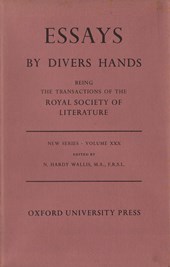 |
The background and the Lecture
First printed in Essays for Divers Hands, being the transactions of the Royal Society of Literature, vol. XXX, Ed. N. Hardy Willis (Oxford University Press, 1960)
Off-print, OUP, thin card cover [1960]; about 100 copies were printed at HW's request
Reprinted in Threnos for T. E. Lawrence and other writings (ed. John Gregory, HWS, 1994; e-book 2014)
This essay is briefly recorded within the ‘Life’s Work’ entry for Richard Jefferies, but merits its own entry here to mark the official recognition of HW's work as a writer.
N. Hardy Willis, the editor of Essays by Divers Hands, notes in his Introduction:
The essay which opens the book by Mr. Williamson on 'Some Nature Writers and Civilization' is really a pleasant study of Jeffries [sic] and Hudson dealing almost entirely with these writers, but with a passing reference to Lawrence. The author is a real lover of his subjects and his quotations are admirably chosen, Perhaps as I am myself a great admirer of both Jeffries and Hudson I may be prejudiced in including this somewhat detailed consideration in a volume of Essays on wider topics; but it is always delightful when an enthusiast writes with enthusiasm, and Mr. Williamson certainly carries his readers with him. The only pity is that the large extent of quotation does not allow enough of his own writing to charm the reader.
*************************
The background and the Lecture:
HW, nominated by William Kean Seymour and seconded by Kenneth Hopkins, was made a Fellow of the Royal Society of Literature on 3 October 1957, recording in his diary:
Very happy day for me.
Fellowship was an honour reserved for 'persons of distinguished literary achievement' and nominations were restricted to authors whose published work was of such literary value as to deserve this high recognition, and had to be ratified by the vote of the council in session.
HW was now entitled to use FRSL after his name: but, although highly cognisant of the honour bestowed upon him, typically he never did so.
A month later he was further honoured by being made a Fellow of the International Institute of Arts and Letters (headquarters in Zurich) and so was also entitled to use FIAL.

(Note it is dated 1 December – HW's birthday: he was 62.)
Then in January 1958 there appeared the HW Special Issue of The Aylesford Review (Vol. II, Number 2, Winter 1957-8), edited by Father Brocard Sewell, containing a series of articles on various aspects of his work. For further information about Fr Brocard, The Aylesford Review and Henry Williamson, see the ‘Life’s Work’ entry for In the Woods (St Albert's Press, 1960).
So HW was being lauded by literary society, but as always his own thoughts were concentrated on the work in hand – the writing of his next book. Love and the Loveless was published on 22 October 1958; the next volume in the Chronicle of Ancient Sunlight series, A Test to Destruction, was under way. In his private life he was caught up in the complications of buying and renovating a house in Capstone Place (or Britannia Row, according to whether one used the front or back door!) in Ilfracombe, the popular seaside fishing town and resort on the coast of North Devon. The caravan in the Field at Ox's Cross was deemed not suitable for family life as young Harry grew older.
Further to his Fellowship of the RSL HW was invited to deliver the prestigious Wedmore Memorial Lecture for 1958. The Wedmore had been inaugurated by Miss Millicent Wedmore in honour of her father Sir Frederick Wedmore (author and art critic, famous for his work on etchings), and it was a considerable honour to be asked to give this. There are several charming letters from Miss Wedmore in HW's archive (now deposited at Exeter University), and to mark the occasion she presented HW with a small volume of her own poems, From a Cornish Moor (1956).
It is clear that the Secretary of the RSL and Miss Wedmore were expecting HW to talk on the subject of Tarka the Otter, but HW felt that would be rather subjective. There was considerable discussion over the choice of subject, but HW held firm. He chose a subject dear to his own heart, and delivered his talk, 'Some Nature Writers and Civilisation', on 9 October 1958. His appointment diary merely notes:
4.30 p.m. Royal Society of Lit. Lecture, I Hyde Park Gardens, W2
while his main diary for that date is a long tirade about domestic affairs (the problems with the new house and Christine's lack of efficient organisation). A few days later he noted:
Last Thursday (9th) I gave a talk on Jefferies & Hudson at the Royal Society of Literature. I did not feel at home there.
This is the first page of the printed lecture:

He took as much care over the writing of this lecture as any of his books, as these draft pages illustrate; the two typescript pages form the first and last pages of his talk, and include instructions to his typist:
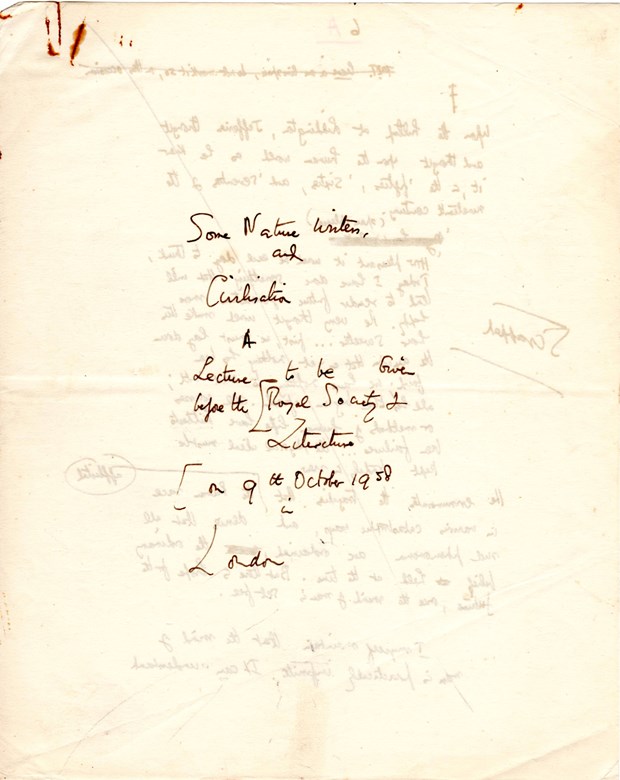
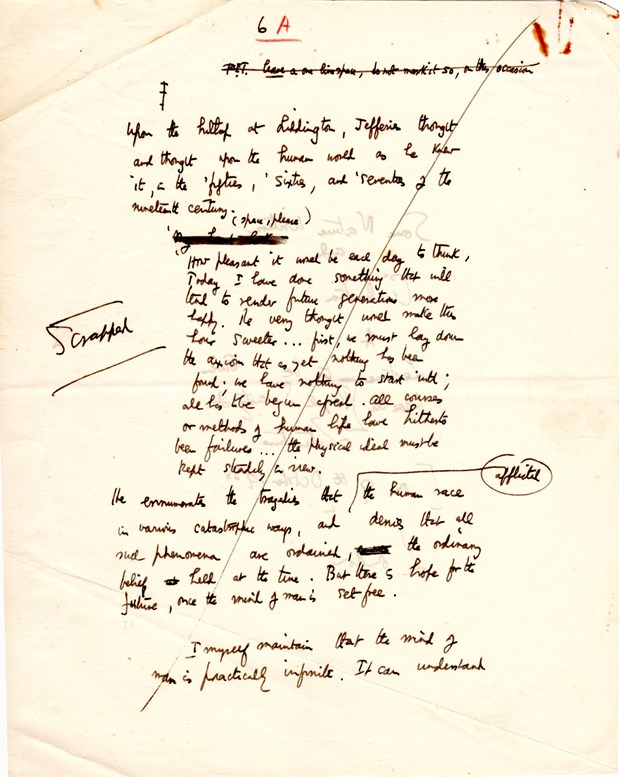
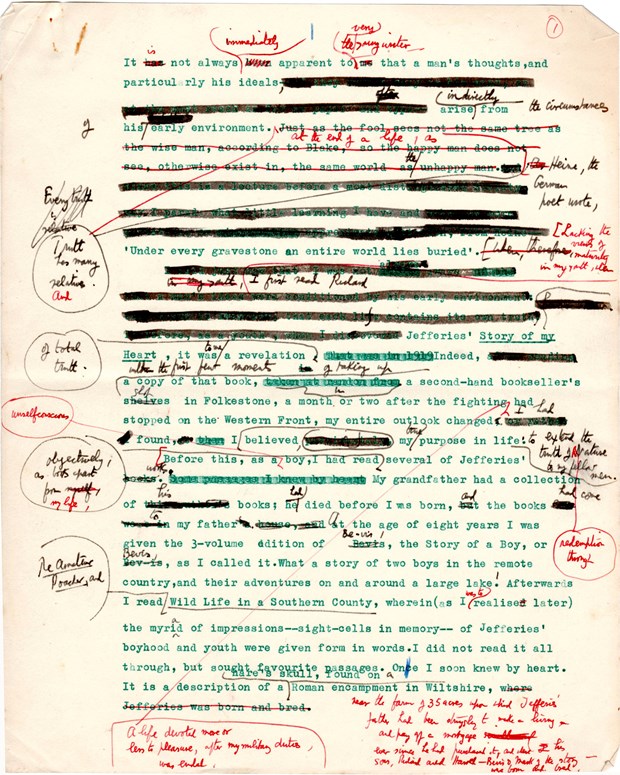
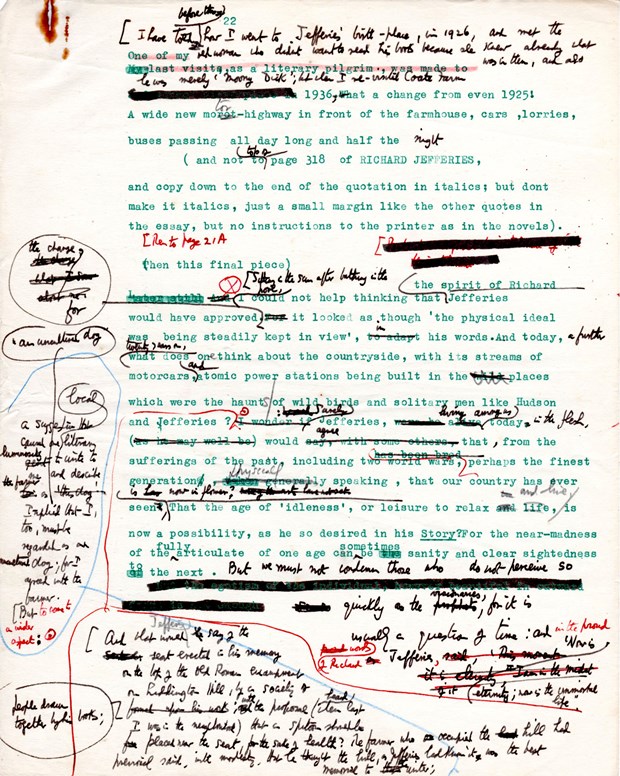
The 'Some Writers', as HW notes, were Richard Jefferies and W. H. Hudson, the two 'nature' writers about whom he had felt most strongly from his early years. His reading, at the age of ten, of Richard Jefferies' Bevis, from his own grandfather's three-volume edition, exploded into his reading of the visionary The Story of My Heart in 1919 at Folkestone, when he was in a vulnerable state of shock from the First World War. The influence of Hudson is not so obvious – there is no actual reference to pin it down, but it is certainly there. I have previously pointed out that the opening lines of Tarka the Otter, noting the trees on the river bank, have a distinct resonance to Hudson's description of the trees that lined the track to his house in Argentina (see Anne Williamson, ‘A Purple Thread (W. H. Hudson)’, HWSJ 41, September 2005).
HW's message here is basically that although the world of Jefferies and Hudson (and that of his own childhood) – the seemingly idyllic world of nature contrasted by the extreme poverty of working men – has disappeared, the turning point being the First World War (and, at the point of writing, a Second World War), there is hope for the present and the future: the slums have vanished and there is tenderness in a new young generation. The emphasis is, though, on an exposition of the lives of his two chosen men, rather than the 'civilisation' aspect.
The lives of Jefferies and Hudson are a metaphor for a natural life – subtly emphasised by mention of D. H. Lawrence's Lady Chatterley's Lover. If we are prepared to live a natural life, and so a life of truth, then we will be, using Jefferies' phrase, 'in eternity now'. And that is what 'civilisation' should be about. HW does however warn that, for some, reading Jefferies’ Story of My Heart can be dangerously influential. (I doubt that was ever really so – other than it upset those with set religious ideas – and it certainly does not apply in today's 'civilisation'.)
As with so much of HW's writing, it is an essay that needs to be read in order to fully understand HW's own philosophy of life.
(HWSJ 41, September 2005, gives full background to HW's connection with these two men. See also: Fred Shepherd, 'A Visit to the Royal Society of Literature', HWSJ 32, September 1996, pp 35-6, which describes the background to HW's Fellowship of the RSL.)
*************************
In the small archive file I have made of items relating to HW's Fellowship of the RSL and the subsequent invitation to give the Wedmore lecture, there are quite a number of cards for other RSL talks over several years. They show an interesting variety. HW did occasionally attend such functions if he was visiting London at the time.
Of particular interest is the occasion of a RSL poetry reading in the presence of the Queen Mother on 1 December 1964, which was of course also HW's 69th birthday.
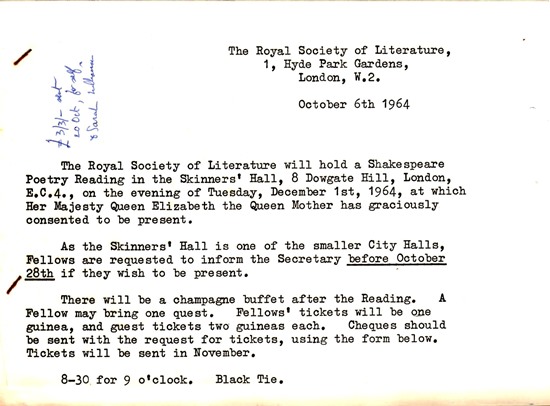
His diary records:
My birthday, 69 years old. Mentioned in Times, & D. Telegraph. Ugh!
At night Sarah W. [his youngest daughter Sarah by his first marriage] & I to Skinner's Hall, to hear poetry readings. Was presented to Queen Mother, who asked 'Did you like the readings'. I said 'Yes your Majesty' but that was a lie. I presented Sarah who curtsied. Rab Butler as President of the Royal Society of Literature stood by the Queen, looking exactly like Vikki's cartoon of him – exquisite anguish on face.
The following photograph recorded the occasion.
 |
|
L to R: Sarah Williamson, HW, HRH the Queen Mother, and the Conservative politician R. A. B. Butler, always known as Rab, later Baron Butler of Saffron Walden |
HW's own inimitable and somewhat irreverent inscription on the back of the photograph reads: 'Sarah Williamson, HW, Lady Birkenhead's arm & left bosom, H.M. Queen Mum, Some Court Gangster, Lord Butler of Trinity House, a Strange Interstellar Object Krawling up His Lordship's Koat-jacket.' Certainly, once the Interstellar Object has been pointed out one sees that and nothing else, particularly that little hand at its base!
(To present Sarah to the Queen Mother was against all the normal rules of state etiquette but, typically, HW did so anyway.)
*************************


Offprint, thin blue card:
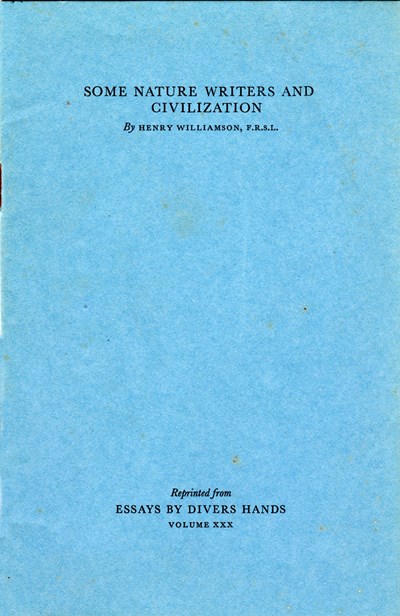
************************
